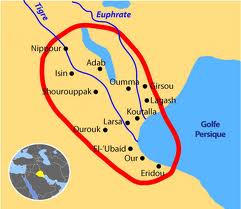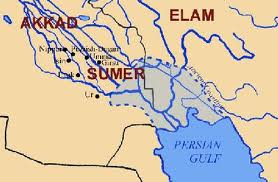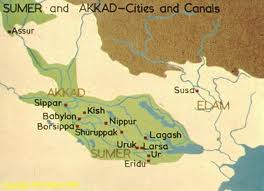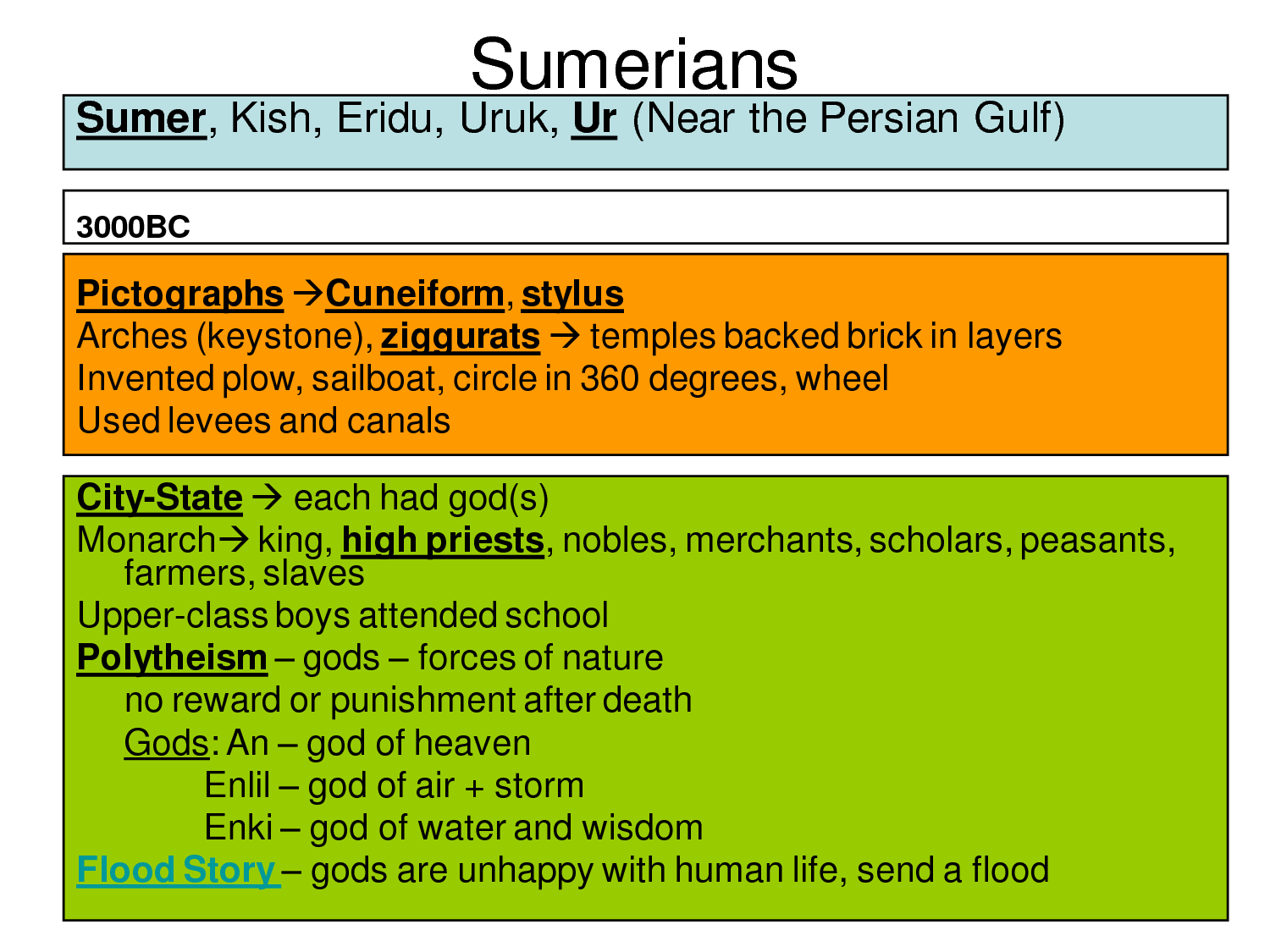



Text source: Wikipedia
SUMER
Sumer (from Akkadian أ…آ umeru; Sumerian ki-en-أ„آir15, approximately "land of the civilized kings" or "native land"[note 1])[1] was an ancient civilization and historical region in southern Mesopotamia, modern Iraq, during the Chalcolithic and Early Bronze Age. Although the earliest historical records in the region do not go back much further than ca. 2900 BC, modern historians have asserted that Sumer was first settled between ca. 4500 and 4000 BC by a non-Semitic people who may or may not have spoken the Sumerian language (pointing to the names of cities, rivers, basic occupations, etc. as evidence).[2] These conjectured, prehistoric people are now called "proto-Euphrateans" or "Ubaidians",[3] and are theorized to have evolved from the Samarra culture of northern Mesopotamia (Assyria).[4][5][6][7] The Ubaidians were the first civilizing force in Sumer, draining the marshes for agriculture, developing trade, and establishing industries, including weaving, leatherwork, metalwork, masonry, and pottery.[3] However, some scholars such as Piotr Michalowski and Gerd Steiner, contest the idea of a Proto-Euphratean language or one substrate language.
Sumerian civilization took form in the Uruk period (4th millennium BC), continuing into the Jemdat Nasr and Early Dy-nastic periods. During the third millennium BC, a close cultural symbiosis developed between the Sumerians (who spoke a Language Isolate) and the Semitic Akkadian speakers, which included widespreadbilingualism.[8] The influ-ence of Sumerian on Akkadian (and vice versa) is evident in all areas, from lexical borrowing on a massive scale, to syntactic, morphological, and phonological convergence.[8] This has prompted scholars to refer to Sumerian and Akkadian in the third millennium as a sprachbund.[8] Sumer was conquered by the Semitic-speaking kings of the Akkadian Empire around 2270 BC (short chronology), but Sumerian continued as a sacred language. Native Su-merian rule re-emerged for about a century in the Third Dynasty of Ur (Sumerian Renaissance) of the 21st to 20th centuries BC, but Akkadian also remained in use. The Sumerian city of Eridu, on the coast of the Persian Gulf, was the world's first city, where three separate cultures fused - that of peasant Ubaidian farmers, living in mud-brick huts and practicing irrigation; that of mobile nomadic Semitic pastoralists living in black tents and following herds of sheep and goats; and that of fisher folk, living in reed huts in the marshlands, who may have been the ancestors of the Sumerians.[9]
The surplus of storable food created by this economy allowed the population of this region to settle in one place, instead of migrating as hunter gatherers. It also allowed for a much greater population density, and in turn required an extensive labour force and division of labour with many specialised arts and crafts. Sumer was also the site of early development of writing, progressing from a stage of proto-writing in the mid 4th millennium BC to writing proper in the third millennium (see Jemdet Nasr period). Origin of name
The term "Sumerian" is the common name given to the ancient non-Semitic inhabitants of southern Mesopotamia, Sumer, by the Semitic Akkadians. The Sumerians referred to themselves as أƒآ¹أ„آ saأ„آ gأƒآg-ga (cuneiform: أ°â€™إ’آ¦ أ°â€™إ • أ°â€™ث†آھ أ°â€™â€ڑآµ), phonetically uأ…‹ saأ…‹ giga, literally meaning "the black-headed people".[10] The Akkadian word Shumer may represent the geographical name in dialect, but the phonological development leading to the Akkadian term أ…آ،umerأƒآ» is uncer-tain.[1][11] Biblical Shinar, Egyptian Sngr and Hittite أ…آ anhar(a) could be western variants of Shumer.[11]
City-states in Mesopotamia
By the late 4th millennium BC, Sumer was divided into about a dozen independent city-states, which were divided by canals and boundary stones. Each was centered on a temple dedicated to the particular patron god or goddess of the city and ruled over by a priestly governor (ensi) or by a king (lugal) who was intimately tied to the city's religious rites. The five "first" cities said to have exercised pre-dynastic kingship:
1. Eridu (Tell Abu Shahrain)
2. Bad-tibira (probably Tell al-Madain)
3. Larsa (Tell as-Senkereh)
4. Sippar (Tell Abu Habbah)
5. Shuruppak (Tell Fara)
Other principal cities:
6. Uruk (Warka)
7. Kish (Tell Uheimir & Ingharra)
8. Ur (Tell al-Muqayyar)
9. Nippur (Afak)
10. Lagash (Tell al-Hiba)
11. Girsu (Tello or Telloh)
12. Umma (Tell Jokha)
13. Hamazi 1
14. Adab (Tell Bismaya)
15. Mari (Tell Hariri) 2
16. Akshak 1
17. Akkad 1
18. Isin (Ishan al-Bahriyat)
(1location uncertain)
(2an outlying city in northern Mesopotamia) Minor cities (from south to north):
1. Kuara (Tell al-Lahm)
2. Zabala (Tell Ibzeikh)
3. Kisurra (Tell Abu Hatab)
4. Marad (Tell Wannat es-Sadum)
5. Dilbat (Tell ed-Duleim)
6. Borsippa (Birs Nimrud)
7. Kutha (Tell Ibrahim)
8. Der (al-Badra)
9. Eshnunna (Tell Asmar)
10. Nagar (Tell Brak) 2
(2an outlying city in northern Mesopotamia)
Apart from Mari, which lies full 330 km (205 mi) northwest of Agade, but which is credited in the king list as having أ¢â‚¬إ“exercised kingshipأ¢â‚¬آ in the Early Dynastic II period, and Nagar, an outpost, these cities are all in the Euphrates-Tigris alluvial plain, south of Baghdad in what are now the Bأ„آپbil, Diyala, Wأ„آپsit, Dhi Qar, Basra, Al-Muthannأ„آپ and Al-Qأ„آپdisiyyah governorates of Iraq.
History
Main article: History of Sumer
The Sumerian city states rose to power during the prehistorical Ubaid and Uruk periods. Sumerian written history reaches back to the 27th century BC and before, but the historical record remains obscure until the Early Dynastic III period, ca. the 23rd century BC, when a now deciphered syllabary writing system was developed, which has allowed archaeologists to read contemporary records and inscriptions. Classical Sumer ends with the rise of the Akkadian Empire in the 23rd century BC. Following the Gutian period, there is a brief "Sumerian renaissance" in the 21st century BC, cut short in the 20th century BC by Semitic Amorite invasions. The Amorite "dynasty of Isin" persisted until ca. 1700 BC, when Mesopotamia was united under Babylonian rule. The Sumerians were eventually absorbed into the Akkadian (Assyro-Babylonian) population.
1 Ubaid period: 5300 to 4100 BC (Pottery Neolithic to Chalcolithic)
2 Uruk period: 4100 to 2900 BC (Late Chalcolithic to Early Bronze Age I)
3 Uruk XIV-V: 4100 to 3300 BC
4 Uruk IV period: 3300 to 3000 BC
5 Jemdet Nasr period (Uruk III): 3000 to 2900 BC
6 Early Dynastic period (Early Bronze Age II-IV)
7 Early Dynastic I period: 2900 to 2800 BC
8 Early Dynastic II period: 2800 to 2600 BC (Gilgamesh)
9 Early Dynastic IIIa period: 2600 to 2500 BC
10 Early Dynastic IIIb period: ca. 2500 to 2334 BC
11 Akkadian Empire period: ca. 2334 to 2218 BC (Sargon)
12 Gutian period: ca. 2218 to 2047 BC (Early Bronze Age IV)
13 Ur III period: ca. 2047 to 1940 BC
Ubaid period
Main article: Ubaid period
The Ubaid period is marked by a distinctive style of fine quality painted pottery which spread through-out Mesopotamia and the Persian Gulf. During this time, the first settlement in southern Mesopotamia was established at Eridu (Cuneiform: NUN.KI), ca. 5300 BC, by farmers who brought with them theHadji Muhammed culture, which first pioneered irrigation agriculture. It appears this culture was derived from the Samarran culture from northern Mesopotamia. It is not known whether or not these were the actual Sumerians who are identified with the later Uruk culture. Eridu remained an important religious center when it was gradually surpassed in size by the nearby city of Uruk. The story of the passing of the me (gifts of civilisation) to Inanna, goddess of Uruk and of love and war, by Enki, god of wisdom and chief god of Eridu, may reflect this shift in hegemony.[13] It appears that this early culture was an amalgam of three distinct cultural influences: peasant farmers, living in wattle and daub or clay brick houses and practicing irrigation agriculture; hunter-fishermen living in woven reed houses and living on floating islands in the marshes (Proto-Sumerians); and Proto-Akkadian nomadic pastoralists, living in black tents.[14]
Uruk period
Main article: Uruk period The archaeological transition from the Ubaid period to the Uruk period is marked by a gradual shift from painted pot-tery domestically produced on a slow wheel to a great variety of unpainted pottery mass-produced by specialists on fast wheels.
By the time of the Uruk period (ca. 4100أ¢â‚¬â€œ2900 BC calibrated), the volume of trade goods transported along the canals and rivers of southern Mesopotamia facilitated the rise of many large, stratified, temple-centered cities (with populations of over 10,000 people) where centralized administrations employed specialized workers. It is fairly certain that it was during the Uruk period that Sumerian cities began to make use of slave labor captured from the hill country, and there is ample evidence for captured slaves as workers in the earliest texts. Artifacts, and even colonies of this Uruk civilization have been found over a wide areaأ¢â‚¬â€from the Taurus Mountains in Turkey, to the Mediterranean Sea in the west, and as far east as Central Iran.[15] The Uruk period civilization, exported by Sumerian traders and colonists (like that found at Tell Brak), had an effect on all surrounding peoples, who gradually evolved their own comparable, competing economies and cultures. The cities of Sumer could not maintain remote, long-distance colonies by military force.[15]
Sumerian cities during the Uruk period were probably theocratic and were most likely headed by a priest-king (ensi), assisted by a council of elders, including both men and women.[16] It is quite possible that the later Sumeri-an pantheon was modeled upon this political structure. There was little evidence of institutionalized violence or professional soldiers during the Uruk period, and towns were generally unwalled. During this period Uruk became the most urbanised city in the world, surpassing for the first time 50,000 inhabitants.
Link to Wikipedia Source
Text source: Wikipedia
ط§طµظ„ ط§ظ„ظ†طµ ظ…ظ† ظ…ظˆظ‚ط¹ ط§ظ„ظˆظƒظٹط¨ظٹط¯ظٹط§
ط³ظˆظ…ط±
ط§ظ„ط±ط§ط¨ط· ظپظٹ ظ…ظˆظ‚ط¹ ط§ظ„ظˆظٹظƒظٹط¨ظٹط¯ظٹط§
You are welocome to send your comments and proposals as well any useful photos, documents, links for website update using our following address:
ط§ظ„طµظپطط© طھط±طط¨ ط¨ط§ظٹط© ظ…ظ„ط§طط¸ط§طھ ط§ظˆ ظ…ظ‚طھط±طط§طھ ظƒظ…ط§ طھطھط·ظ„ط¹ ظ„ط§ط³طھظ„ط§ظ… ط§ظٹط© طµظˆط± ط§ظˆ ظˆط«ط§ط¦ظ‚ ط§ظˆ ط±ظˆط§ط¨ط· ظ…ظپظٹط¯ط© ظ„طھطط¯ظٹط«ظ‡ط§ ط¹ط¨ط± ط§ظ„ظ…ط±ط§ط³ظ„ط© ط¹ظ„ظ‰ ط§ظ„ط¹ظ†ظˆط§ظ† ط§ظ„ط§ظ„ظƒطھط±ظˆظ†ظٹ ط§ظ„طھط§ظ„ظٹ
info@uruk-warka.dk
Other updates ... طھطط¯ظٹط«ط§طھ ط§ط®ط±ظ‰
CITY-STATES OF ANCIENT - SUMER ... ط¯ظˆظ„ ط§ظ„ظ…ط¯ظ† ظپظٹ ط³ظˆظ…ط±
New Book about Cuneiform - ظƒطھط§ط¨ ط¬ط¯ظٹط¯ ط¹ظ† ط§ظ„ظ„ط؛ط© ط§ظ„ظ…ط³ظ…ط§ط±ظٹط©
Mesopotamia (Sumerians, first civilization on earth) - ط§ظ„ط³ظˆظ…ط±ظٹظˆظ† ط§ظ„طط¶ط§ط±ط© ط§ظ„ط§ظˆظ„ظ‰ ط¹ظ„ظ‰ ط§ظ„ط§ط±ط¶
The British Museum - ط§ظ„ظ…طھطظپ ط§ظ„ط¨ط±ظٹط·ط§ظ†ظٹ
Eridu Photos - طµظˆط± ظ…ظ† ط§ط±ظٹط¯ظˆ
Ur Photos - طµظˆط± ظ…ظ† ط§ظˆط±
Uruk Photos - طµظˆط± ظ…ظ† ط§ظˆط±ظˆظƒ
Ubaid Photos - طµظˆط± ظ…ظ† ط§ظ„ط¹ط¨ظٹط¯
Tell el-â€کOueili Photos - طµظˆط± ظ…ظ† طھظ„ ط§ظ„ط¹ظˆظٹظ„
Uruk Photos - طµظˆط± ظ…ظ† ظ„ط§ط±ط³ط§
Tell Lahm (Kisiga) Photos - طµظˆط± ظ…ظ† طھظ„ ظ„طظ…
British Museum, Basra Project - ط§ظ„ظ…طھطظپ ط§ظ„ط¨ط±ظٹط·ط§ظ†ظٹ - ظ…ط´ط±ظˆط¹ ط§ظ„ط¨طµط±ط©